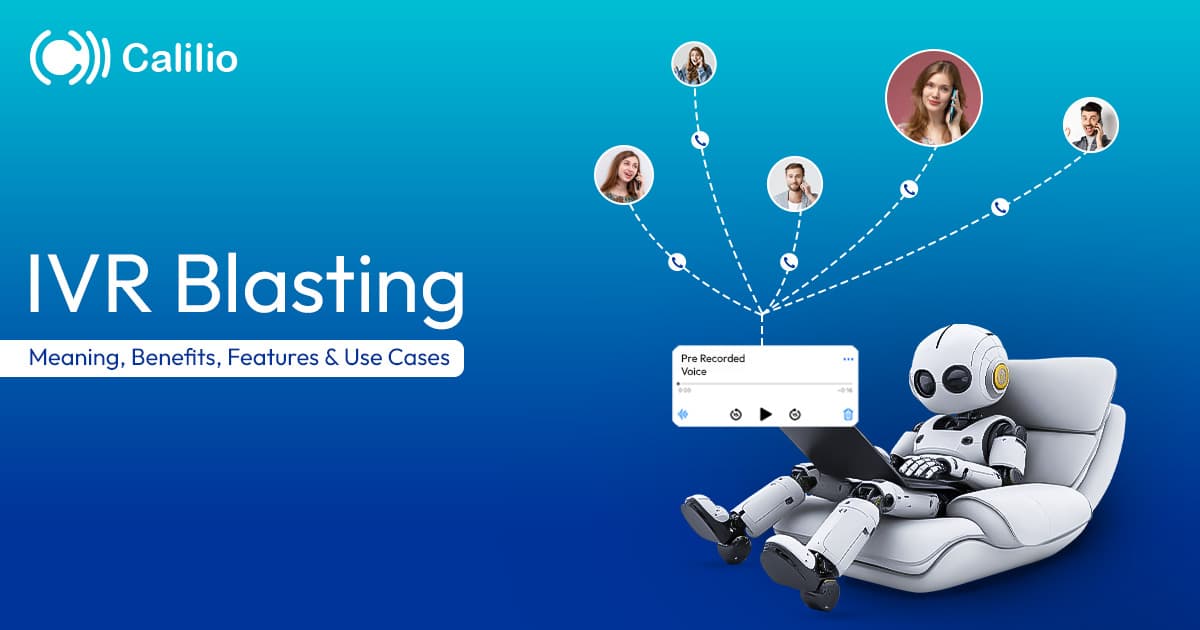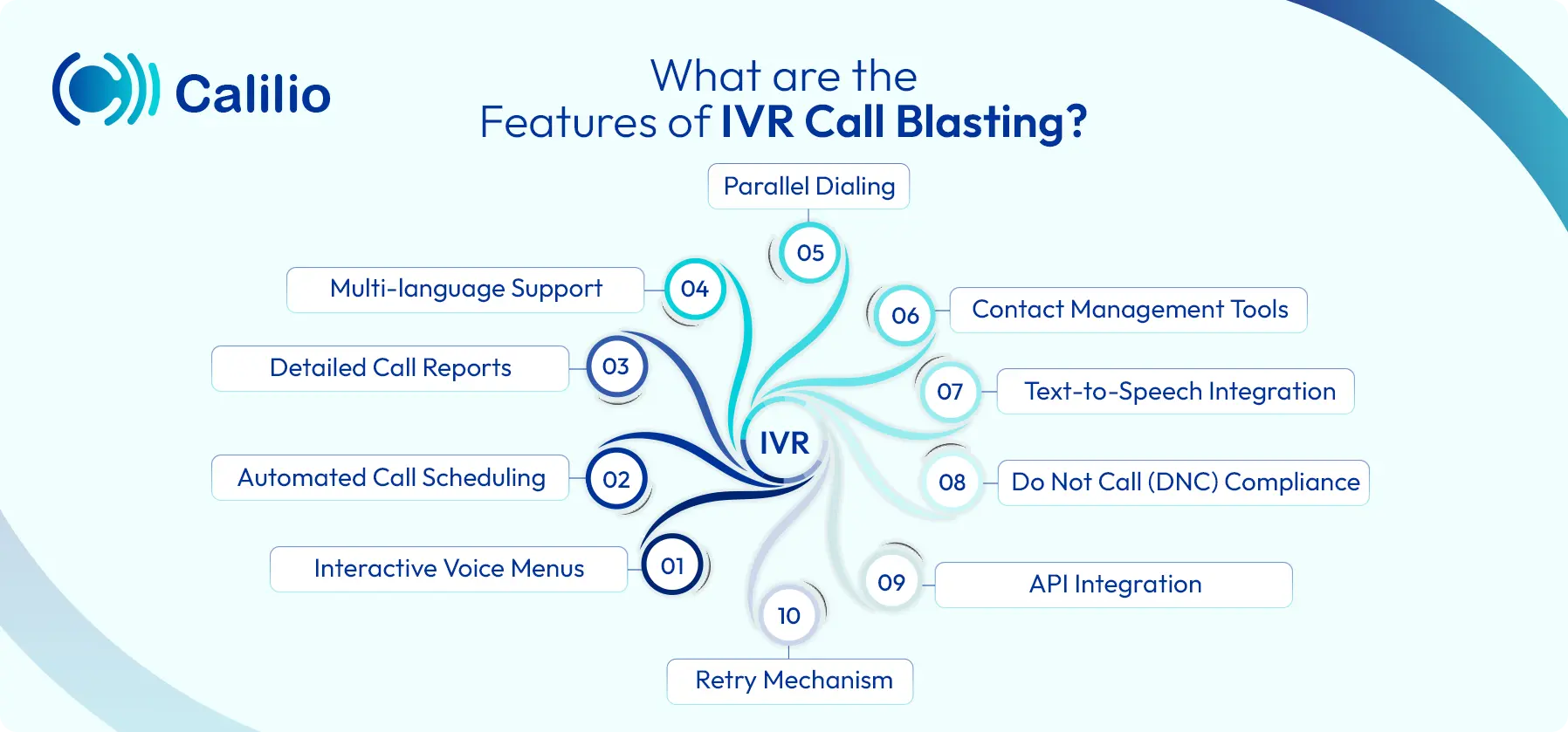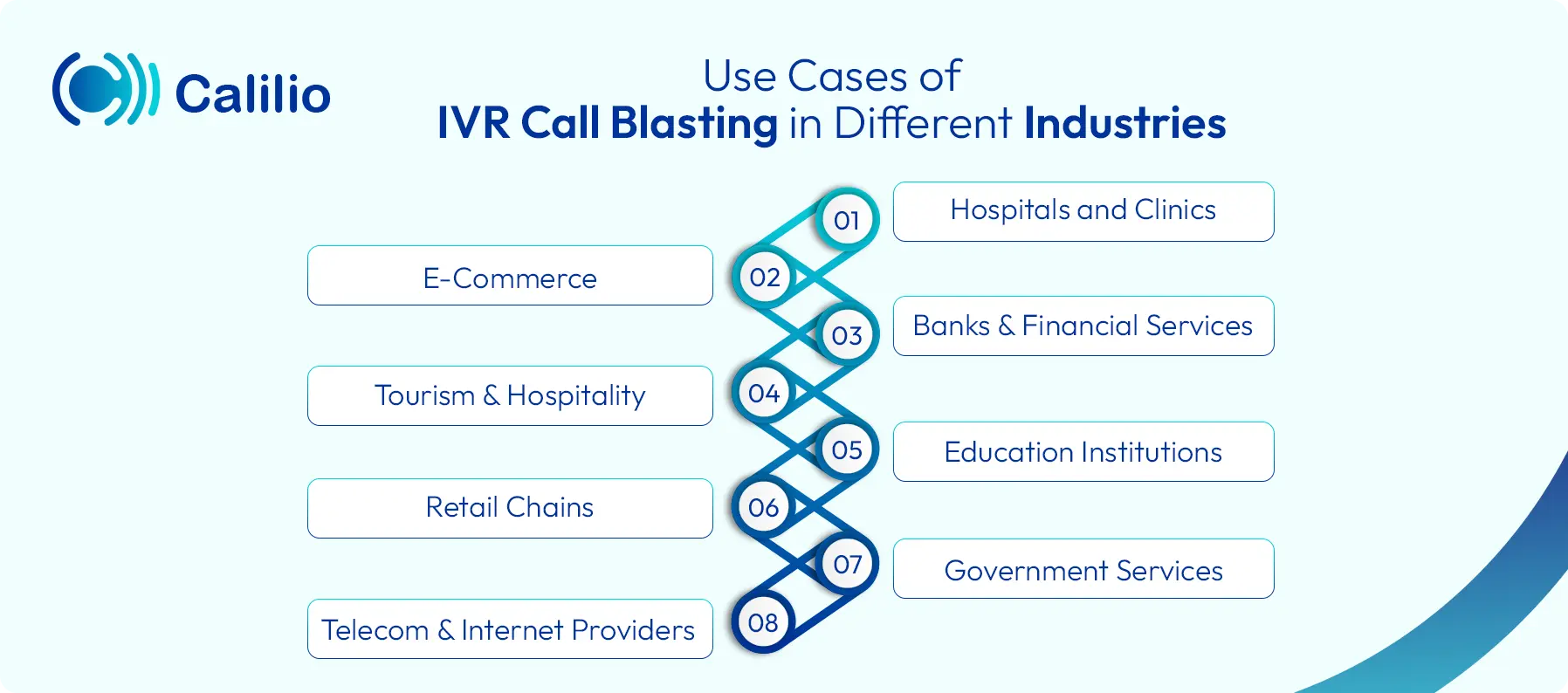What is IVR Blasting? How It Works, Benefits, and Use Cases

Contacting a lot of people to share or ask about the same information can be challenging. If you are a business operator, then your team has to repeat the same message all day long. Furthermore, it is not even guaranteed that you would reach your intended recipient. The call might end up getting ignored or transferred to voicemail.
Thankfully, IVR blasting offers a better way of making automatic outgoing calls. Plus, it adds options for people to respond right away. This makes your communication more efficient, all without adding extra work for your team.
In this guide, let's learn what IVR blasting is, how it works, its best practices, and its many advantages.
Key Highlights:
IVR blasting is a large-scale outbound IVR solution that sends interactive voice calls to many recipients at once. It combines automated call delivery with keypad or voice input, allowing recipients to respond instantly.
It is suitable for reminders, surveys, promotions, alerts, and updates across industries like healthcare, banking, e-commerce, tourism, and education.
It also helps businesses segment responses, identify interested leads, and trigger automated follow-ups without manual effort.
IVR voice blasting includes features like real-time tracking, call reports, multi-language support, and DNC compliance for better control and performance.
IVR blaster reduces operational costs and manual workload while improving response rates and communication efficiency.
What is IVR Blasting?
IVR blasting refers to the process of sending pre-recorded, interactive voice calls to a large number of recipients at once. It is a type of outbound IVR that combines the features of Interactive Voice Response (IVR) technology with call blasting capabilities.
It’s designed for high-volume outreach while keeping the interaction structured and automated.
How Does IVR Blasting Work?
IVR blasting process starts when a business records a voice message, like a discount alert or service reminder, and adds simple response options. The system then calls and plays the message to multiple contacts. As customers respond, the platform tracks inputs and can even trigger automatic follow-ups.
Step 1: Record the Message
Whether you’re announcing a special discount, running a political campaign, or sending a payment reminder, record a clear and engaging voice message. You can either upload a recorded file or use a built-in text-to-speech tool. Such calls include simple instructions, like press 1 for this or press 2 for that.
Step 2: Upload Your Contacts
Next, you upload the list of people you want to reach. This could include existing customers, new leads, or any custom contact group. Most IVR platforms let you import phone numbers from spreadsheets or Customer Relationship Management (CRM) services with just a few clicks.
Step 3: Start the IVR Blast
Once your message and contacts are ready, it’s time to launch the blast. The system begins placing automated calls at scale, playing the recorded message to each recipient. You can control the speed of the campaign depending on your service provider; for example, hundreds or even thousands of calls per minute.
Step 4: Customer Picks Up and Listens
When someone answers the call, they hear the voice message you prepared. If the message includes options, they can respond using their phone keypad (DTMF tones) or voice. For example, they might press “1” to confirm attendance or “3” to request a callback.
Step 5: Response Handling and Monitoring
As responses come in, the system automatically tracks what each recipient does. It logs who answered, what input they gave, who requested follow-ups, and who didn't respond. You can monitor this activity in real time through a dashboard.
Step 6: Analyze the Results
After the blast ends, all data, like call success rates, keypress actions, opt-outs, and no-answers, gets stored in one place. This helps your team understand how people responded and identify what worked or what needs improvement in future campaigns.
Step 7: Set Up Auto Follow-Ups
To boost engagement, you can also configure automatic follow-up calls. For example, if someone missed the call or pressed “2” to get more details, the system can call them back at a better time or connect them directly to a live agent.
Manage High Volume of Phone Calls Conveniently with an Affordable IVR System!
What are the Features of IVR Call Blasting?
Some of the common features of IVR blasting are interactive voice menus, automated call scheduling, detailed call reports, multi-language support, parallel dialing, and text-to-speech integration, among others.

- Interactive Voice Menus: IVR blasting supports DTMF input (keypad responses) or voice commands, allowing recipients to engage with the call instead of just listening passively.
- Automated Call Scheduling: You can set exact dates and times for when the IVR blast should start, pause, or repeat, ensuring delivery at the right moment.
- Detailed Call Reports: The system generates in-depth reports showing call delivery status, user responses, duration, and drop-offs, helping you track performance with precision.
- Multi-language Support: You can record or generate messages in multiple languages to suit diverse audiences without building separate campaigns.
- Parallel Dialing: The system can handle thousands of calls at once, dialing multiple contacts simultaneously without delays or lags.
- Contact Management Tools: Built-in features let you filter, sort, or segment contact lists before launching a campaign for more organized targeting.
- Text-to-Speech Integration: If you don’t have a recorded voice file, the system can convert your written script into natural-sounding speech in various voices and languages.
- Do Not Call (DNC) Compliance: IVR call blasting tools often include DNC filtering and timezone-based dialing to stay compliant with regional regulations.
- API Integration: Many platforms allow integration with CRMs, helpdesk software, or analytics tools, making it easy to sync data across systems.
- Retry Mechanism: If a call fails or goes unanswered, the system can retry based on custom retry rules, improving reach without manual effort.
What are the Advantages of IVR Voice Blasting?
IVR blasting makes it easy to flow information and details to a wide range of consumers and get real-time feedback. Plus, it further helps identify who’s genuinely interested in doing business with you. Moreover, it works on any phone, that too without internet, ensuring a wider reach and better accessibility.
1. Categorization Based on Interest
You can divide recipients based on how they respond during the call. For example, people who press “1” to learn more can be tagged as interested leads, while others may be marked for follow-up or opt-out. This helps you focus on the right audience.
2. Massive Scalability
Whether you’re contacting hundreds or thousands, IVR blasting handles it smoothly. It's far more scalable than email or manual dialing and reaches users instantly, even in rural or offline regions.
3. Fully Customizable Experience
Voice messages can be tailored by region, language, or even tone. You can personalize content to suit specific campaigns, demographics, or local preferences for a more relevant experience.
4. Run IVR Surveys with Ease
Instead of sending links or physical forms, you can launch an IVR survey to a wider audience and collect real-time feedback directly over the phone. Customers simply press buttons to share opinions, making it easier to gather large-scale insights quickly.
5. No App or Internet Needed
Since IVR runs on standard phone lines, customers don’t need smartphones or internet access. It works just as well on landlines, making it more inclusive for all users.
6. Lower Operating Costs
IVR blasting automates outreach without needing extra staff. You avoid the cost of hiring agents for manual calls or surveys, and get accurate and structured responses.
7. Convenient for Your Customers
People can respond quickly by pressing a key; no need to download apps, write emails, or fill out long forms. This makes them more likely to engage with your message.
Is IVR Blasting the Same as Call Blasting?
No, IVR blasting is not the same as call blasting. However, they are somewhat similar. While both IVR blasting and call blasting involve sending voice messages to multiple recipients, the key difference lies in interaction.
Call blasting is a one-way communication method. It simply delivers a pre-recorded message to many people at once, with no option to respond or take action.
IVR blasting, on the other hand, adds an interactive layer. Recipients can respond to the call using their keypad or voice; for example, by pressing a number to confirm, give feedback, or connect to a live agent. This makes IVR blasting more dynamic and suitable for cases where businesses need a reply, not just delivery.
Best Practices for IVR Blasts
For effective IVR blasts, keep your message short and get to the point quickly. Give clear instructions with simple options, and avoid overloading them with choices.
Make the message feel local or familiar to boost engagement. Always call at a time when they’re likely to answer, and test your blast before going live to avoid errors. Lastly, respect opt-out requests and avoid calling restricted numbers.
1. Keep Your Messages Short and On Point
Avoid dragging the conversation. Long introductions or drawn-out explanations can push the listener to hang up before you even reach the point. Keep it crisp, clear, and focused on what matters most.
2. Give Simple Options with Clear Instructions
Confusing menus are one of the main reasons people hang up. Make your instructions easy to follow by offering clear, simple choices. Also, don’t overwhelm them with too many options. Stick to two or three relevant actions to keep things straightforward and easy to respond to.
3. Adapt to Your Audience
People are more likely to engage when the message sounds familiar or personal. Send the call in their preferred language, tone, or dialect if possible. A little localization goes a long way in boosting interaction.
4. Call at the Right Time
Timing matters. Avoid calling early in the morning, late at night, or during work hours, unless it's urgent information. Schedule your blasts during reasonable, non-intrusive hours when people are more likely to answer.
5. Test Before You Launch
Always run a test blast before going live. This helps you catch errors in your script, voice recording, or call flow that could ruin the listener’s experience.
6. Respect Opt-Outs and DNC Preferences
If someone presses a key to opt out, make sure your system records that. Also, avoid calling numbers on national Do Not Call lists to stay compliant and avoid penalties.
Use Cases of IVR Call Blasting in Different Industries
IVR blasting services help businesses and organizations like hospitals, banks, online shops, and educational institutions quickly deliver messages to a wide audience while also gathering responses. From alerts to promotions, it adds speed, scale, and interaction, all in a single call.

- Hospitals and Clinics: Send reminders for vaccination, follow-up appointments, or prescription refills. Patients can confirm by pressing a key or request a callback.
- E-Commerce: Share limited-time discounts or flash sales alerts. Customers can press a key to know more, get a promo code, or complete their order.
- Banks and Financial Services: Send EMI or credit card due alerts, fraud verification calls, or loan approval updates. Customers can confirm, dispute, or connect to a representative instantly.
- Tourism and Hospitality: Promote seasonal travel packages, hotel discounts, or early check-in options. Recipients can book directly or get itinerary info through simple keypresses.
- Education Institutions: Notify students or parents about admission deadlines, exam dates, or fee reminders. Responses can be used to confirm attendance or request help.
- Retail Chains: Use IVR blasts for store reopening announcements, loyalty program alerts, or stock clearance events. Shoppers can opt in for more details or store directions.
- Government Services: Alert the public about local campaigns, health programs, or emergency updates. Citizens can respond to confirm participation or report issues.
- Telecom and Internet Providers: Notify users of billing updates, service outages, or upgrade options. IVR menus can help them confirm renewals or talk to support without waiting.
Conclusions
IVR blasting is a smart and scalable way to communicate with a large audience through voice calls. It takes the manual effort out of repeating the same message and replaces it with a system that automatically delivers, interacts, and records responses. Whether you're running a campaign, sending reminders, or collecting feedback, IVR blasting helps get your message across faster and more efficiently.
From hospitals to banks, retail stores to government offices, IVR blasting fits into various industries that rely on mass outreach. With the right message, clear instructions, and proper timing, businesses can improve engagement and response rates while saving time and costs. It’s fast, interactive, and ready to support communication at scale.
Your Phone System Just Got Cheaper
Virtual numbers from just $2/month
Call rates starting as low as $0.016/min
The most cost-effective VoIP phone system for businesses
Powered by advanced AI telephony features
Compare low-cost business phone systems
Frequently Asked Questions
How much does IVR blasting cost?
IVR blasting typically costs between $50 to $500 per month, depending on call volume, duration, and added features like CRM integration or multi-language support.
Can IVR blasting be personalized?
Is IVR blasting legal to use for promotions or surveys?

Still have questions?
Can’t find the answer you’re looking for? Please chat with our friendly team.
Stay in the loop
Get the latest call insights, trends, and updates delivered straight to your inbox.
By subscribing, you agree to receive updates from Calilio.
You can unsubscribe anytime.
Phone numbers
Get International Phone Numbers
Singapore
|Australia
|New Zealand